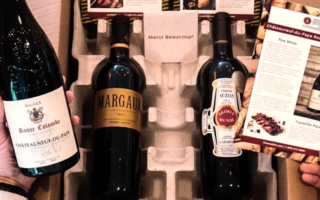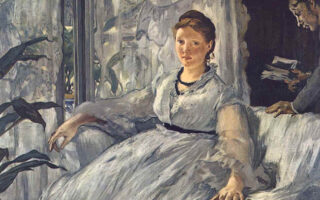Chateau La Tour Haut-Brion: guillotines, gravel and glorious wine
576
In the cluster
of wines produced by the Dillon family there are the great Chateau
Haut-Brion and Chateau La Mission Haut-Brion. But in another corner of
their land lies a small vineyard called Chateau La Tour Haut-Brion.
This is an ancient property, and today produces the frugal
connoisseur’s choicest red wine. In
1500 the vineyard, situated on a poor gravelly soil, was owned by Louis
Rostaing, one of the few proprietors of the time not in ecclesiastic
garb. In the 18th century this small parcel was known as Chateau
Saige-Formanoir, and belonged to the widow of Guillaume Saige. When the
fury of the French Revolution swept through Bordeaux, the maiden voyage
of the guillotine down the tracks was to sever the head of her son.
Madame Saige must have been a tough old bird though, because she
refused to flee. As a result, her lands and the vineyard were never
confiscated. By mid-20th
century, La Tour had been absorbed by La Mission Haut-Brion, and for a
time the name was used to identify the second wine of the estate.
However, with the acquisition of La Mission by the Dillon family, La
Tour Haut-Brion is once again a wine made on its own. Chateau
La Tour Haut-Brion, grand cru classé, is a lovely wine, and superior to
La Mission’s second label, La Chapelle Haut-Brion. It is reasonably
priced, but unfortunately because the vineyard is only a dozen acres in
size, not widely availably. However, it is worth seeking out. While
some of the Bordeaux red wines in the Graves district can be imperious
in nature (note that I do not use the typical wine columnist’s
verbiage) La Tour Haut-Brion comes right up to you and, without
apology, shakes your hand. It is a round and rich smoky wine which will
come of age more quickly in the bottle than the adjoining La Mission. What
you get from La Tour Haut-Brion that may be lacking in some of the
other small vineyards of the region is the extraordinary knowledge of
wine making that comes with the property. Jean Delmas, and his father
before him, and now with his son, has been masterminding the making of
Chateau Haut-Brion, the premier grand cru, all his life. When the
Dillon family acquired La Mission in 1983 as well, he took up its
reins–to mix the metaphor–as well. The result is that the man widely
considered to be the best director of wine in Bordeaux plans every last
detail in the making of Chateau La Tour Haut-Brion. Glorious, glorious, glorious. But don’t tell too many people or the supply will vanish. —David Outerbridge has a B.A. from Harvard, and an M.A. from New York University. He has written seven books, and has been involved with a number of books from conception to final draft with different authors.
- SUBSCRIBE
- ALREADY SUBSCRIBED?
BECOME A BONJOUR PARIS MEMBER
Gain full access to our collection of over 5,000 articles and bring the City of Light into your life. Just 60 USD per year.
Find out why you should become a member here.
Sign in
Fill in your credentials below.
In the cluster
of wines produced by the Dillon family there are the great Chateau
Haut-Brion and Chateau La Mission Haut-Brion. But in another corner of
their land lies a small vineyard called Chateau La Tour Haut-Brion.
This is an ancient property, and today produces the frugal
connoisseur’s choicest red wine.
of wines produced by the Dillon family there are the great Chateau
Haut-Brion and Chateau La Mission Haut-Brion. But in another corner of
their land lies a small vineyard called Chateau La Tour Haut-Brion.
This is an ancient property, and today produces the frugal
connoisseur’s choicest red wine.
In
1500 the vineyard, situated on a poor gravelly soil, was owned by Louis
Rostaing, one of the few proprietors of the time not in ecclesiastic
garb. In the 18th century this small parcel was known as Chateau
Saige-Formanoir, and belonged to the widow of Guillaume Saige. When the
fury of the French Revolution swept through Bordeaux, the maiden voyage
of the guillotine down the tracks was to sever the head of her son.
Madame Saige must have been a tough old bird though, because she
refused to flee. As a result, her lands and the vineyard were never
confiscated.
1500 the vineyard, situated on a poor gravelly soil, was owned by Louis
Rostaing, one of the few proprietors of the time not in ecclesiastic
garb. In the 18th century this small parcel was known as Chateau
Saige-Formanoir, and belonged to the widow of Guillaume Saige. When the
fury of the French Revolution swept through Bordeaux, the maiden voyage
of the guillotine down the tracks was to sever the head of her son.
Madame Saige must have been a tough old bird though, because she
refused to flee. As a result, her lands and the vineyard were never
confiscated.
By mid-20th
century, La Tour had been absorbed by La Mission Haut-Brion, and for a
time the name was used to identify the second wine of the estate.
However, with the acquisition of La Mission by the Dillon family, La
Tour Haut-Brion is once again a wine made on its own.
century, La Tour had been absorbed by La Mission Haut-Brion, and for a
time the name was used to identify the second wine of the estate.
However, with the acquisition of La Mission by the Dillon family, La
Tour Haut-Brion is once again a wine made on its own.
Chateau
La Tour Haut-Brion, grand cru classé, is a lovely wine, and superior to
La Mission’s second label, La Chapelle Haut-Brion. It is reasonably
priced, but unfortunately because the vineyard is only a dozen acres in
size, not widely availably. However, it is worth seeking out. While
some of the Bordeaux red wines in the Graves district can be imperious
in nature (note that I do not use the typical wine columnist’s
verbiage) La Tour Haut-Brion comes right up to you and, without
apology, shakes your hand. It is a round and rich smoky wine which will
come of age more quickly in the bottle than the adjoining La Mission.
La Tour Haut-Brion, grand cru classé, is a lovely wine, and superior to
La Mission’s second label, La Chapelle Haut-Brion. It is reasonably
priced, but unfortunately because the vineyard is only a dozen acres in
size, not widely availably. However, it is worth seeking out. While
some of the Bordeaux red wines in the Graves district can be imperious
in nature (note that I do not use the typical wine columnist’s
verbiage) La Tour Haut-Brion comes right up to you and, without
apology, shakes your hand. It is a round and rich smoky wine which will
come of age more quickly in the bottle than the adjoining La Mission.
What
you get from La Tour Haut-Brion that may be lacking in some of the
other small vineyards of the region is the extraordinary knowledge of
wine making that comes with the property. Jean Delmas, and his father
before him, and now with his son, has been masterminding the making of
Chateau Haut-Brion, the premier grand cru, all his life. When the
Dillon family acquired La Mission in 1983 as well, he took up its
reins–to mix the metaphor–as well. The result is that the man widely
considered to be the best director of wine in Bordeaux plans every last
detail in the making of Chateau La Tour Haut-Brion.
you get from La Tour Haut-Brion that may be lacking in some of the
other small vineyards of the region is the extraordinary knowledge of
wine making that comes with the property. Jean Delmas, and his father
before him, and now with his son, has been masterminding the making of
Chateau Haut-Brion, the premier grand cru, all his life. When the
Dillon family acquired La Mission in 1983 as well, he took up its
reins–to mix the metaphor–as well. The result is that the man widely
considered to be the best director of wine in Bordeaux plans every last
detail in the making of Chateau La Tour Haut-Brion.
Glorious, glorious, glorious. But don’t tell too many people or the supply will vanish.
—
David Outerbridge has a B.A. from Harvard, and an M.A. from New York University. He has written seven books, and has been involved with a number of books from conception to final draft with different authors.
David Outerbridge has a B.A. from Harvard, and an M.A. from New York University. He has written seven books, and has been involved with a number of books from conception to final draft with different authors.


